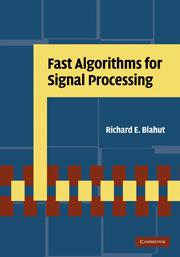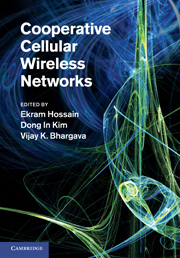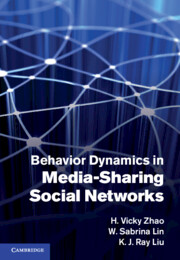Refine search
Actions for selected content:
6790 results in Communications and signal processing
Contents
-
- Book:
- Entropy of Hidden Markov Processes and Connections to Dynamical Systems
- Published online:
- 05 June 2011
- Print publication:
- 26 May 2011, pp v-vi
-
- Chapter
- Export citation
8 - Factors of Gibbs measures for full shifts
-
-
- Book:
- Entropy of Hidden Markov Processes and Connections to Dynamical Systems
- Published online:
- 05 June 2011
- Print publication:
- 26 May 2011, pp 246-257
-
- Chapter
- Export citation
6 - The capacity of finite-state channels in the high-noise regime
-
-
- Book:
- Entropy of Hidden Markov Processes and Connections to Dynamical Systems
- Published online:
- 05 June 2011
- Print publication:
- 26 May 2011, pp 179-222
-
- Chapter
- Export citation
3 - A note on a complex Hilbert metric with application to domain of analyticity for entropy rate of hidden Markov processes
-
-
- Book:
- Entropy of Hidden Markov Processes and Connections to Dynamical Systems
- Published online:
- 05 June 2011
- Print publication:
- 26 May 2011, pp 98-116
-
- Chapter
- Export citation
7 - Computing entropy rates for hidden Markov processes
-
-
- Book:
- Entropy of Hidden Markov Processes and Connections to Dynamical Systems
- Published online:
- 05 June 2011
- Print publication:
- 26 May 2011, pp 223-245
-
- Chapter
- Export citation
4 - Bounds on the entropy rate of binary hidden Markov processes
-
-
- Book:
- Entropy of Hidden Markov Processes and Connections to Dynamical Systems
- Published online:
- 05 June 2011
- Print publication:
- 26 May 2011, pp 117-171
-
- Chapter
- Export citation

Fast Algorithms for Signal Processing
-
- Published online:
- 03 May 2011
- Print publication:
- 24 June 2010

Cooperative Cellular Wireless Networks
-
- Published online:
- 03 May 2011
- Print publication:
- 10 March 2011

Complex-Valued Matrix Derivatives
- With Applications in Signal Processing and Communications
-
- Published online:
- 03 May 2011
- Print publication:
- 24 February 2011

Behavior Dynamics in Media-Sharing Social Networks
-
- Published online:
- 28 April 2011
- Print publication:
- 14 April 2011
Part II - Behavior forensics in media-sharing social networks
-
- Book:
- Behavior Dynamics in Media-Sharing Social Networks
- Published online:
- 28 April 2011
- Print publication:
- 14 April 2011, pp 55-56
-
- Chapter
- Export citation
4 - Game theory for social networks
- from Part I - Introduction
-
- Book:
- Behavior Dynamics in Media-Sharing Social Networks
- Published online:
- 28 April 2011
- Print publication:
- 14 April 2011, pp 41-54
-
- Chapter
- Export citation
References
-
- Book:
- Behavior Dynamics in Media-Sharing Social Networks
- Published online:
- 28 April 2011
- Print publication:
- 14 April 2011, pp 326-334
-
- Chapter
- Export citation
6 - Leveraging side information in colluder social networks
- from Part II - Behavior forensics in media-sharing social networks
-
- Book:
- Behavior Dynamics in Media-Sharing Social Networks
- Published online:
- 28 April 2011
- Print publication:
- 14 April 2011, pp 85-110
-
- Chapter
- Export citation
Preface
-
- Book:
- Behavior Dynamics in Media-Sharing Social Networks
- Published online:
- 28 April 2011
- Print publication:
- 14 April 2011, pp xi-xii
-
- Chapter
- Export citation
Frontmatter
-
- Book:
- Behavior Dynamics in Media-Sharing Social Networks
- Published online:
- 28 April 2011
- Print publication:
- 14 April 2011, pp i-vi
-
- Chapter
- Export citation
Part III - Fairness and cooperation stimulation
-
- Book:
- Behavior Dynamics in Media-Sharing Social Networks
- Published online:
- 28 April 2011
- Print publication:
- 14 April 2011, pp 129-130
-
- Chapter
- Export citation
8 - Game-theoretic modeling of colluder social networks
- from Part III - Fairness and cooperation stimulation
-
- Book:
- Behavior Dynamics in Media-Sharing Social Networks
- Published online:
- 28 April 2011
- Print publication:
- 14 April 2011, pp 131-168
-
- Chapter
- Export citation
3 - Overview of mesh-pull peer-to-peer video streaming
- from Part I - Introduction
-
- Book:
- Behavior Dynamics in Media-Sharing Social Networks
- Published online:
- 28 April 2011
- Print publication:
- 14 April 2011, pp 24-40
-
- Chapter
- Export citation
10 - Optimal pricing for mobile video streaming
- from Part III - Fairness and cooperation stimulation
-
- Book:
- Behavior Dynamics in Media-Sharing Social Networks
- Published online:
- 28 April 2011
- Print publication:
- 14 April 2011, pp 195-218
-
- Chapter
- Export citation
